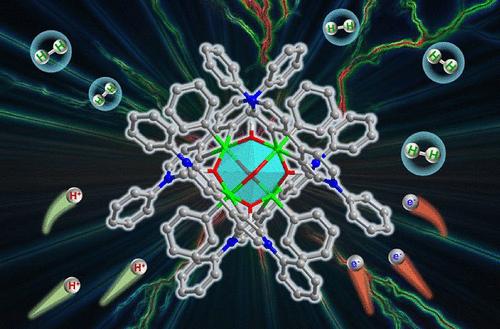stiboviologens修饰Sb4O6簇在电子海绵和质子发动机耦合电催化质子还原中的应用
IF 15.6
1区 化学
Q1 CHEMISTRY, MULTIDISCIPLINARY
引用次数: 0
摘要
锑基材料由于其独特的电子结构和高效的质子-电子转移能力,在析氢反应(HER)催化方面具有广阔的应用前景。然而,尽管其潜力巨大,但sb基催化剂的分子水平发展一直受到重大合成挑战的阻碍,特别是难以构建明确定义的分子结构,例如sb -卟啉或簇。在此,我们报告了一种新的合成策略,通过stiboviologens的定向氧化偶联来获得两个新的stiboviologens修饰的Sb4O6簇(SbVO-Me和SbVO-Ph)。SbVO-Me和SbVO-Ph表现出优异的氧化还原活性、多电子转移能力和强大的电致变色行为。DFT计算和静电势映射分析揭示了一种电子-质子合作管理机制:紫外光段充当“电子海绵”,介导电荷的积累和传递,而六氧化四锑(Sb4O6)核心充当“质子发动机”,加速质子的传输。在均相酸性HER催化中,系统的过电位为535 mV,法拉第效率为74.5%。固定化后,异质系统的活性增强,过电位降低至182mv。机制研究支持一种涉及暴力因子和Sb中心的合作催化途径。本研究引入了一种新的主要基团分子催化剂,扩大了基于viologens的氧化还原系统的设计范围,并为质子偶联电催化提供了新的机会。本文章由计算机程序翻译,如有差异,请以英文原文为准。

Stiboviologens-Decorated Sb4O6 Clusters for Electrocatalytic Proton Reduction via Coupled Electron Sponge and Proton Engine
Antimony (Sb)-based materials show great promise for hydrogen evolution reaction (HER) catalysis owing to their unique electronic structures and efficient proton–electron transfer capabilities. However, despite their potential, the molecular-level development of Sb-based catalysts has been hindered by significant synthetic challenges, particularly the difficulty in constructing well-defined molecular architectures, such as Sb–porphyrins or clusters. Herein, we report a new synthetic strategy to access two novel stiboviologens-decorated Sb4O6 clusters (SbVO-Me and SbVO-Ph) via directed oxidative coupling of stiboviologens. SbVO-Me and SbVO-Ph exhibit excellent redox activity, multielectron transfer capacity, and robust electrochromic behavior. DFT calculations and electrostatic potential mapping analyses reveal a cooperative electron–proton management mechanism: the viologen moiety acts as an “electron sponge,” mediating charge accumulation and delivery, while the tetraantimony hexaoxide (Sb4O6) core serves as a “proton engine” to accelerate proton transport. In homogeneous acidic HER catalysis, the system achieves an overpotential of 535 mV with a Faradaic efficiency of 74.5%. Upon immobilization, the heterogeneous system delivers enhanced activity with a reduced overpotential of 182 mV. Mechanistic investigations support a cooperative catalytic pathway involving the viologens and Sb centers. This study introduces stiboviologens as a new class of main-group molecular catalysts, expanding the design landscape for viologen-based redox systems and offering new opportunities in proton-coupled electrocatalysis.
求助全文
通过发布文献求助,成功后即可免费获取论文全文。
去求助
来源期刊
CiteScore
24.40
自引率
6.00%
发文量
2398
审稿时长
1.6 months
期刊介绍:
The flagship journal of the American Chemical Society, known as the Journal of the American Chemical Society (JACS), has been a prestigious publication since its establishment in 1879. It holds a preeminent position in the field of chemistry and related interdisciplinary sciences. JACS is committed to disseminating cutting-edge research papers, covering a wide range of topics, and encompasses approximately 19,000 pages of Articles, Communications, and Perspectives annually. With a weekly publication frequency, JACS plays a vital role in advancing the field of chemistry by providing essential research.

 求助内容:
求助内容: 应助结果提醒方式:
应助结果提醒方式:


